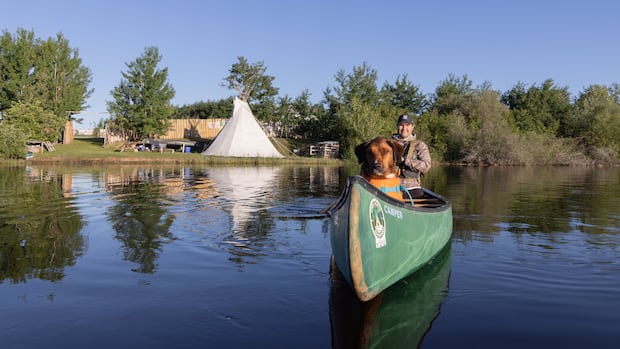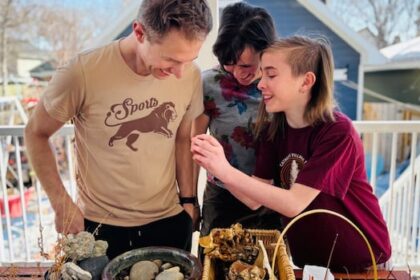Saskatchewan·First PersonBlaine Mirasty grew up learning traditional Cree ways, even while around him, prejudice was common toward Indigenous people. Now he’s launched an Indigenous tourism business, which gives him a chance to show people ‘Miyo-pimatisiwin,’ or how to live a good life.Through my business, I show visitors what it means to live a good life in Cree cultureBlaine Mirasty · for CBC First Person · Posted: Nov 04, 2025 4:00 AM EST | Last Updated: 4 hours agoListen to this articleEstimated 7 minutesBlaine Mirasty enjoys a paddle at Cree North Adventures, the tourism operation he launched on the banks of the Meadow River, on Treaty 6 in Saskatchewan. (Submitted by Blaine Mirasty)This First Person article is the experience of Blaine Mirasty, who is Cree from Flying Dust First Nation, Saskatchewan and lives in Edmonton. For more information about CBC’s First Person stories, please see the FAQ. WARNING: This story contains details of experiences at residential schools.I was eight when my dad started teaching me how to set snares, identify different animal tracks and how to spot a rabbit trail in the bush trails around our home in Flying Dust First Nation. Shortly after, I snared a rabbit, while my father showed me how we’d lay down tobacco and pay respect to the Creator for allowing us to eat. With time, I learned how to set better snares by trial and error and how to read the rabbit paths in the snow. I would take the skinned rabbit to my grandmother’s place down the road, where she’d turn it into rabbit stew served with bannock. To me, traditional native food is always more satisfying to eat, as you gain better respect for the animal after harvesting it yourself and going through the process of snaring, cleaning and watching how it is made into a stew.These memories are threads in the larger fabric of what it means to be Nehiyaw (Cree) ��— and to be rooted in what we call Miyo-pimatisiwin or “the good life.” Mirasty learned how to hunt and snare rabbits from a young age. These are lessons he’s carried into adulthood. (Submitted by Blaine Mirasty)Miyo-pimatisiwin means finding balance in all aspects of life, including emotional, spiritual, mental and physical well-being. It means living in harmony and shared respect with yourself, your community and the natural world. So many people don’t understand “the good life.”When I was growing up, learning or experiencing First Nation and Indigenous cultures wasn’t common. My Indigenous friends and I were often subject to jeers on the ice and questionable referee calls at hockey games visiting rural towns. We’d be followed around stores as if clerks were expecting us to steal. My father and I were once stopped by the police because we were driving “too nice” a vehicle. In Saskatchewan, there was an underlying prejudice from the white population against Indigenous people. Despite it all, I always tried to be a glass half-full type of person, despite knowing as a First Nation Cree, I’d just have to work twice as hard as others to earn the same opportunities.In 2018, I got the chance to study in Norway for a semester abroad at university, which turned out to be an eye-opening experience. I would wear my beaded Edmonton Oiler beaver winter mitts around and when I met new people, I would tell them I was from a native community in the middle of Canada. I viewed it as an opportunity to be proud of where I come from, knowing I might be the only First Nation person they would ever meet. I got to meet people of different nationalities and cultures; it was a sharing and learning experience on both sides.When I came back, I felt even more proud of my culture and how I grew up and it got me thinking of how I can incorporate authentic Nehiyaw experiences with family in my own back yard.Mirasty, second from the right, bought a tipi in 2019 and erected it on the banks of the Meadow River in Saskatchewan. That was the launch of his tourism business, Cree North Adventures. (Submitted by Blaine Mirasty)In 2019, I decided to buy my first tipi for $500 on Kijiji. I cut the poles and cleared out the overgrown bush by hand on our family property adjacent to the Meadow River in Saskatchewan and set up what would become an Instagram-worthy tipi spot with northern lights views and a unique forest bathing accommodation. With this, Cree North Adventures was born.I didn’t want to create a five-star luxury resort; instead, this site was about feeding, welcoming and accommodating guests in a way that reflects my own traditions. When I received my first booking, it was proof that I could build something meaningful — with my own hands, from my own culture and that people really cared about it. I’ve worked alongside my family to share history and stories from both Plains Cree and Woodland Cree perspectives. My grandmother, Deloras Blackmon from Canoe Lake Cree First Nation, has shared her knowledge of plants, traditional medicines and life growing up on the trapline in Treaty 10. Other family members have contributed by offering traditional dance presentations and horse wagon rides. The goal is to create a meaningful and immersive cultural experience for our guests. I’ve met people of all walks of life, shared stories and traditions, and helped teach the next generation about the land and our cultural practices.Every guest I’ve welcomed, whether they’ve come from a nearby community or from across the world, have taught me something about Miyo-pimatisiwin.With his business, Mirasty hopes to give people a chance to enjoy authentic experiences. (Submitted by Blaine Mirasty)One of the most meaningful moments came when two brothers from Ontario with heritage to Flying Dust First Nation booked a stay with me. They had grown up in the foster care system, disconnected from their culture and community. When they attended the local powwow that weekend, our leadership welcomed them back with a blanket ceremony. That was a true demonstration of healing, connection and balance — Miyo-pimatisiwin in action.It’s a good feeling to earn money from Cree North Adventures and while it’s not my full-time occupation or financially lucrative yet, my outlook on having guests is that they walk away with a unique experience and having learned something about Nehiyaw people. People coming out to Cree North Adventures are increasingly showing an interest in learning about Indigenous culture and knowledge, says Mirasty. (Submitted by Blaine Mirasty)Since the 2015 Truth and Reconciliation Commission’s Calls to Action and the 2021 discoveries of potential unmarked graves at former residential schools, I’ve noticed a real shift from the ignorance I saw as a child. WATCH | The joy in seeing Indigenous culture embraced:Indigenous people share the small acts of reconciliation that have meant the mostAhead of the fifth National Day for Truth and Reconciliation, we asked people at the First Nations University of Canada about the small acts of reconciliation that have meant the most, from non-Indigenous people wearing orange or attending powwows, to schools and universities shining a light on Indigenous culture and knowledge. There’s been more effort, awareness and genuine action toward reconciliation and supporting the self-determination of Indigenous peoples. Today, there are nearly 3,000 Indigenous tourism businesses and entrepreneurs across the country, each with their own stories to tell. And that number is growing.The Northern Lights can be seen at times amidst the forest surroundings of Cree North Adventures. (Submitted by Blaine Mirasty)Travellers are starting to understand that by choosing to support these Indigenous-owned tourism businesses they are helping to create economic sovereignty for Indigenous peoples. In turn, these visitors are helping to strengthen cultural preservation, community pride and economic self- determination.While Indigenous tourism offers opportunity, what I do isn’t just about growing a business. It’s about carrying on what my father taught me as we snared rabbits in the bush. It’s carrying out the work of connection, reciprocity and teaching that keeps our communities grounded in Miyo-pimatisiwin.A national 24-hour Indian Residential School Crisis Line is available at 1-866-925-4419 for emotional and crisis referral services for survivors and those affected. Mental health counselling and crisis support are also available 24 hours a day, seven days a week through the Hope for Wellness hotline at 1-855-242-3310 or by online chat.Do you have a compelling personal story that can bring understanding or help others? We want to hear from you. Email sask-first-person-grp@cbc.ca to learn more. ABOUT THE AUTHORBlaine Mirasty is a Cree tourism entrepreneur who grew up on the Flying Dust First Nation in Treaty 6 in northern Saskatchewan. He and his family own and operate Cree North Adventures, offering authentic First Nation cultural experiences and unique accommodations on the banks of the Meadow River in their home reserve.
Indigenous tourism helps me share Miyo-pimatisiwin and other lessons my dad taught me











